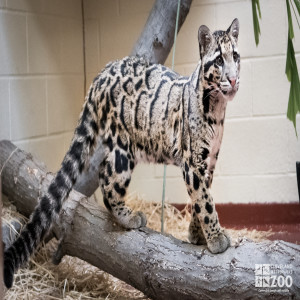 The Clouded leopard is a medium sized cat with a golden or greyish coat that is patterned with large cloud shaped markings that are dark brown with a black outline. The shoulder and back markings are darker towards the rear. It appears to be an evolutionary bridge between the genus Panthera (big cats e.g. tiger, lion, etc.) and the genus Felis (small cats). It differs from the large cats because it has a ridgid hyoid bone and so is incapable of roaring and because the pupils contract to a spindle like a small cats’ pupils. It differs from the small cats by the low level of grooming behavior it exhibits and by its posture at rest: tail straight out behind and forelegs straight out in front. They have powerful short and stout legs. They stand 10-16 inches tall, measure 36.5 inches from nose to base of the tail. The tail is full and long (30 inches). Males can weigh up to 50 pounds, while the somewhat smaller female weighs up to 35 pounds. The skull and teeth are strikingly leopard like (possibly an adaptation for catching birds, thus allowing it to easily bite through feathers). Its upper canine teeth are the longest, for their skull size, of any living carnivore. The snout is rather broad, although the head itself is quite narrow. Eyes are usually yellow.
The Clouded leopard is a medium sized cat with a golden or greyish coat that is patterned with large cloud shaped markings that are dark brown with a black outline. The shoulder and back markings are darker towards the rear. It appears to be an evolutionary bridge between the genus Panthera (big cats e.g. tiger, lion, etc.) and the genus Felis (small cats). It differs from the large cats because it has a ridgid hyoid bone and so is incapable of roaring and because the pupils contract to a spindle like a small cats’ pupils. It differs from the small cats by the low level of grooming behavior it exhibits and by its posture at rest: tail straight out behind and forelegs straight out in front. They have powerful short and stout legs. They stand 10-16 inches tall, measure 36.5 inches from nose to base of the tail. The tail is full and long (30 inches). Males can weigh up to 50 pounds, while the somewhat smaller female weighs up to 35 pounds. The skull and teeth are strikingly leopard like (possibly an adaptation for catching birds, thus allowing it to easily bite through feathers). Its upper canine teeth are the longest, for their skull size, of any living carnivore. The snout is rather broad, although the head itself is quite narrow. Eyes are usually yellow.
Location: The Upper RainForest
Share:
Range
Range from the Himalayan foothills in Nepal through mainland Southeast Asia into China south of the Yangtze. It was reported extinct on the island of Taiwan. The Clouded leopards in Sumatra and Borneo are considered a separate species (Neofelis diardi).
Habitat
Prefer dense tropical evergreen forests and at times drier forests if there is enough suitably sized prey.
Conservation Status
Vulnerable
Primary Threats
Human Wildlife Coexistence
Gestation
85-93 days
Litter
1-5 cubs, 2 being most common
Behavior
Clouded leopards are carnivores and rarely seen in the wild. They are primarily nocturnal, and at times crepuscular. They live in forest elevations of up to 8,000 feet and spend much of their lives in trees. Their bodies are well adapted to this arboreal lifestyle. While their strong tails help them to balance while perched on tree branches, their specially adapted ankle bones, large paws, sharp claws and foot pads which can conform to the shape of the branch allow them to both climb while hanging upside down under branches, hang from branches with their hind feet and even descend down trees head first. The ankle bones of the hind feet allow the foot to rotate backwards. When a clouded leopard spots its prey on the forest floor, it leaps down on it from above. The social behavior of clouded leopards is virtually unknown, although they are thought to be solitary animals.
Reproduction
Clouded leopards are sexually mature at around the age of 2 years. Mating can occur in any month. Females can produce a litter every year, and cubs become independent at approximately 10 months
Wild Diet
They are thought to prey upon both arboreal and terrestrial animals including birds, squirrels, monkeys, deer and wild
Zoo Diet

